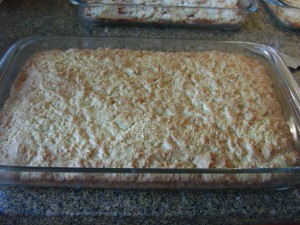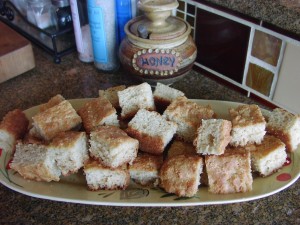I love quick breads because they are well, quick. (The department of redundancy department is going to love that sentence!) And this lovely bread is my “go to” bread when I don’t have time for a yeast bread to rise. (Darling little yeasty beasties take time to work their magic, after all!) And since you were wondering why that is, I thought I’d offer you a brief explanation of how leavening agents work. (Think of this as really simple baking chemistry 101.) Active Dry Yeast (a living microscopic fungus) is activated by giving it a nice warm bath and then something yummy to eat. (Sounds like the start of my day, but without the coffee!) Yeast works as the leavening in bread dough by eating the sugars (sucrose and fructose) or by converting the starch in flour into sugar. The byproduct of all this sugar being gobbled is CO2. When CO2 is released it is trapped in the bread dough’s elastic web of gluten, in much the same way air is trapped when a balloon is inflated. And although yeasty beasties are hungry little cuties, they can only eat so fast! Thus the time it takes for yeast bread to rise. In this recipe I am using 2 other types of leavening agents, baking soda and baking powder. Baking soda (sodium bicarbonate) is alkaline in nature, and when combined with an acid and a liquid, in this case the acidic buttermilk, it creates carbon dioxide bubbles, giving rise to the dough. Baking powder, which is basically a blend of an acid like sodium acid pyrophosphate and an alkali (sodium bicarbonate – baking soda), produces the same chemical reaction when added to a liquid. Again, carbon dioxide is the byproduct. The interesting part about baking soda when mixed with an acid liquid, and baking powder when mixed with any liquid, is that in both cases, gases begin to be released immediately. (No waiting time required.) And in the case of Double-acting baking powder (which is mostly what you find in your average grocery store), it releases leavening gases on contact with moisture and again during the baking process. A double whammy of leavening action! When a recipe calls for both baking powder and baking soda, like this recipe does, the baking powder does most of the leavening. The baking soda is mainly added to neutralize some of the acid and to help ensure a tender crumb. Note: baking soda and baking powder are not considered interchangeable in a recipe. Bottom line (and what would be on a pop quiz if I were mean enough to give you one): Yeast takes time to release enough gas to raise dough. Baking soda, a simple alkaline, has to be paired with an acidic liquid to begin its task of immediately releasing leavening gases. And baking powder, since it is a combination of both an acid and an alkali just requires liquid to start its gaseous behavior. Whew – that hurt my brain! So now that you know more about leavening agents than you ever wanted to know, give this bread a try. It’s delicious, even if it does contains bicarbonate this and acidic that.
- 2 c. flour
- 4 T. sugar + 1 tsp. for sprinkling
- 1 ½ tsp. baking powder
- 1 tsp. salt
- ¾ tsp. baking soda
- 3 T. cold butter
- 1 c. buttermilk
Whisk together the flour, 4 tablespoons sugar, baking powder, salt, and baking soda. Using your cheese grater, grate the butter on top of the flour mixture. (Butter right out of the refrigerator is at the perfect temperature for grating.) Then using your hands, gently squish the butter into the flour until the mixture resembles coarse meal. Make a well in the flour and add the buttermilk. Gently mix the buttermilk into the flour. Do not over mix. (I find the best implement for mixing soft, sticky dough like this one is a regular table knife.) Gently scoop the dough into a lightly greased 9-inch cake pan. Don’t bother smoothing out the dough or trying to make it pretty in the pan. As it bakes it will smooth out and look lovely. Sprinkle the dough with the remaining 1 teaspoon sugar. Bake in a pre-heated 375 degree oven for about 30 minutes or until the top is brown and a toothpick inserted into the center comes out clean. Cool for about 10 minutes in the pan before transfering to a rack. Serve warm or at room temperature.


